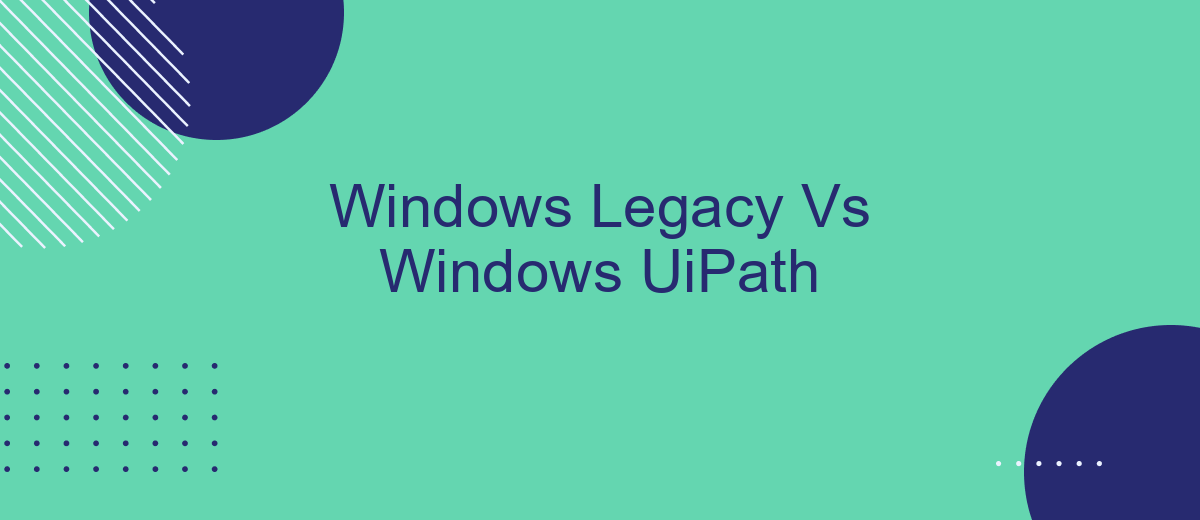In the ever-evolving landscape of technology, comparing legacy systems with modern automation tools is crucial for businesses. This article delves into the differences between traditional Windows Legacy systems and the innovative Windows UiPath platform. By examining their functionalities, advantages, and limitations, we aim to provide a comprehensive understanding to help organizations make informed decisions about their technological investments.
Introduction
As technology continues to evolve, the demand for efficient automation solutions has never been higher. Windows Legacy and Windows UiPath are two prominent platforms that cater to this need, each offering unique features and capabilities. Understanding the differences between these platforms can help organizations make informed decisions about which tool best suits their automation requirements.
- Windows Legacy: A traditional platform known for its robustness and extensive support for legacy applications.
- Windows UiPath: A modern automation tool that leverages advanced AI and machine learning capabilities to streamline processes.
Both platforms have their own strengths and weaknesses. While Windows Legacy is ideal for maintaining and integrating older systems, Windows UiPath excels in automating complex workflows with minimal manual intervention. For businesses looking to integrate various services seamlessly, tools like SaveMyLeads can further enhance these platforms by automating data transfers and improving overall efficiency.
Key Differences

Windows Legacy and Windows UiPath differ significantly in their approach and functionality. Windows Legacy refers to older versions of the Windows operating system, which were primarily designed for personal and business use with a focus on local applications and traditional desktop environments. On the other hand, Windows UiPath is a modern automation platform that integrates with the Windows ecosystem to streamline and automate business processes. UiPath offers tools for robotic process automation (RPA), enabling users to create automated workflows that can interact with various software applications, reducing manual effort and increasing efficiency.
Another key difference lies in their integration capabilities. Windows Legacy systems often require manual setup and configuration for integrating different software applications, which can be time-consuming and prone to errors. In contrast, Windows UiPath provides seamless integration through its extensive library of pre-built connectors and APIs. Services like SaveMyLeads can further enhance this integration process by automatically linking various applications and services, allowing businesses to automate data transfers and workflows effortlessly. This results in improved productivity and a more streamlined operational environment.
Similarities

When comparing Windows Legacy and Windows UiPath, it's essential to recognize that both platforms offer robust solutions for automation and task management in various business environments. Despite their differences, they share several commonalities that make them both valuable tools for organizations looking to streamline their operations.
- Both Windows Legacy and Windows UiPath provide comprehensive automation capabilities, allowing users to automate repetitive tasks and workflows efficiently.
- They both support integration with various third-party applications and services, such as SaveMyLeads, which helps to streamline data transfer and communication between different platforms.
- Each platform offers a user-friendly interface that enables users to design and manage automation processes with minimal coding knowledge, making them accessible to a broader range of users.
These similarities highlight the fundamental strengths of both Windows Legacy and Windows UiPath in enhancing productivity and operational efficiency. By leveraging their automation capabilities and integration support, businesses can achieve significant improvements in their workflows and overall performance.
Advantages and Disadvantages

When comparing Windows Legacy and Windows UiPath, it's essential to consider their respective advantages and disadvantages. Windows Legacy systems are known for their stability and long-term support. They are familiar to many users and have a vast repository of software compatibility. However, they often lack modern features and can be less efficient in handling contemporary workflows.
On the other hand, Windows UiPath offers a more modern and user-friendly interface. It supports automation and integration with various services, making it ideal for businesses looking to streamline their processes. For example, using tools like SaveMyLeads, users can easily set up integrations and automate data transfers between different platforms, enhancing productivity and reducing manual work.
- Windows Legacy: Stability, long-term support, extensive software compatibility.
- Windows Legacy: Outdated features, less efficient for modern workflows.
- Windows UiPath: Modern interface, supports automation, easy integration with services like SaveMyLeads.
- Windows UiPath: May have a steeper learning curve for users unfamiliar with new technologies.
In conclusion, the choice between Windows Legacy and Windows UiPath depends on the specific needs of the user or organization. While Windows Legacy offers reliability and familiarity, Windows UiPath provides modern capabilities and enhanced automation, making it a powerful tool for today's business environment.
Conclusion
In comparing Windows Legacy and Windows UiPath, it is evident that both have their unique strengths and cater to different user needs. Windows Legacy offers a robust and familiar environment for traditional desktop applications, ensuring stability and reliability. On the other hand, Windows UiPath brings modern automation capabilities, streamlining processes and enhancing productivity through advanced robotic process automation (RPA) tools.
Choosing between the two depends largely on the specific requirements of the user or organization. For those looking to integrate various services seamlessly, tools like SaveMyLeads can be invaluable. SaveMyLeads allows users to automate lead data transfer between different platforms, thereby optimizing workflow and reducing manual effort. Ultimately, the decision should be guided by the desired balance between legacy stability and modern automation efficiency.
- Automate the work with leads from the Facebook advertising account
- Empower with integrations and instant transfer of leads
- Don't spend money on developers or integrators
- Save time by automating routine tasks
FAQ
What is the main difference between Windows Legacy and Windows UiPath?
Can I use Windows UiPath on Windows Legacy systems?
How does UiPath enhance automation compared to traditional Windows scripting?
Is it necessary to upgrade to a newer Windows version to use UiPath effectively?
What services can help integrate UiPath with other applications on Windows?
What do you do with the data you get from Facebook lead forms? Do you send them to the manager, add them to mailing services, transfer them to the CRM system, use them to implement feedback? Automate all of these processes with the SaveMyLeads online connector. Create integrations so that new Facebook leads are automatically transferred to instant messengers, mailing services, task managers and other tools. Save yourself and your company's employees from routine work.

